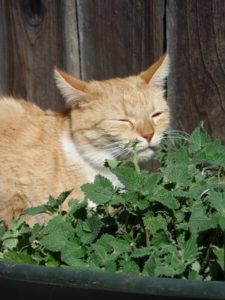A new study published by Science Advances shows that catnip, the famous flowering herb that makes some cats go wild, triggers the reward system in the brain of cats, but its main function is probably to ward off mosquitoes and other pests. Thanks to the compound nepetalactone, catnip does double-duty by causing some cats to feel good while protecting them at the same time.
The compound nepetalactone, which is considered a volatile iridoid, is similar to a cat’s pheromones. The new study found that the opioid system that regulates euphoria is activated when cats sniff catnip or silver vine. In response, they tend to roll all over it, rub their faces on it, and cover themselves in the smell. This same study discovered that the cats who rolled around in the catnip were also better protected against mosquitoes.
So should cat owners run out and get some catnip for their furry felines?

Photo courtesy: Pixabay Public Domain
Roughly two-thirds of felines, domestic and wild, react to catnip and elicit playfulness, such as rolling around, rubbing their cheeks, or pawing the air since catnip produces a euphoric effect in those who respond. When cats rub their heads and bodies on catnip, they’re also covering themselves in a natural mosquito and pest deterrent. But not all felines react to catnip.
Catnip, sometimes referred to as catmint since it’s part of the mint family, has long been known to affect some cats’ behaviors – either as a stimulant or a sedative, especially with the large number of catnip toys on the market. But science has only begun to look at what is in the catnip that changes their brain activity and why it only affects some cats and not others.
In a 2017 study, published by BMC Veterinary Research, 100 domestic cats were tested with catnip, silver vine, honeysuckle, and valerian root to observe their responses. The results were in line with other studies that discovered one-in-three cats do not respond to catnip. Cats may respond to catnip by sniffing, biting, or licking it, rubbing their head against it, rolling around with it, or pawing it playfully. It is not believed to be harmful or addictive.

Photo courtesy: Pixabay Public Domain
Another study in May 2020 delved into the mechanisms for iridoid biosynthesis of Nepeta, or catnip. The study looked at the evolution of the major component of silver vine and catnip, nepetalactone, and suggested its main function is to “protect against herbivorous insects.” The fact that cats react or don’t react to it is secondary.
Early literature suggests a cat reacts to catnip due to an inherited dominant gene, and kittens under six to eight weeks old do not respond at all. It is believed that a response – if the cat has inherited the gene – may not fully develop until the cat is about three months old.
Catnip is considered safe for cats, but PetMD warns that too much catnip may cause vomiting, dizziness, diarrhea, or trouble walking. Fresh catnip is more potent than dried, so cats need less of the fresh stuff to have a good time. It’s advised to use catnip as a treat. Over-exposure could desensitize cats, and they may no longer exhibit a reaction.
Catnip is widely available in assorted cat toys, but it’s also sold as a fresh or dried herb. Cat owners can grow catnip themselves, as well. Vet West Animal Hospitals suggests using catnip by rubbing it on your cat’s scratching post, placing it on your cat’s favorite toy, sprinkling it in a new environment, or using it in your cat’s crate to help with car rides.
But what about cats who don’t respond to catnip? In the 2017 study, researchers found that cats responded to silver vine, valerian root, and honeysuckle as well. Nearly 80 percent of the cats tested responded to silver vine, and about 50 percent responded to honeysuckle, as well as valerian root. For the group of cats who did not respond to the catnip, about 75 percent of those cats did respond to silver vine, making silver vine a good choice for cats who may show no interest in catnip.
And how about dogs? Do dogs benefit from the potent herb? According to Healthy Paws Pet Insurance, catnip is also safe for dogs. However, catnip acts as a sedative in dogs and therefore should be monitored closely. Always consult with your veterinarian before introducing catnip to either your dog or cat.
Featured Photo Courtesy: Public Domain Pictures







